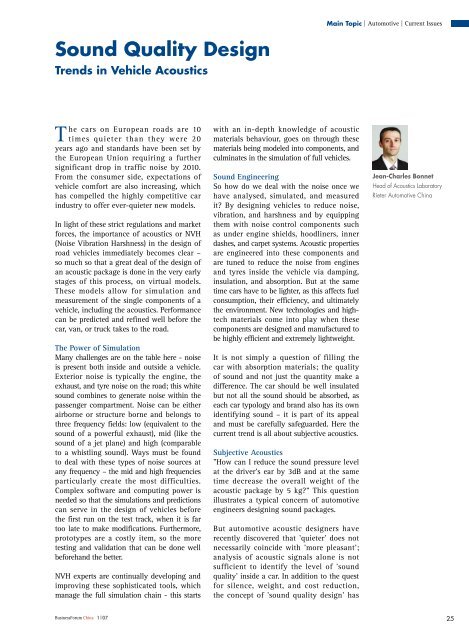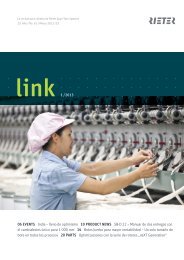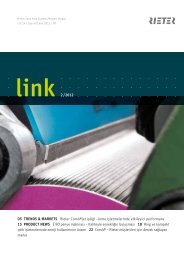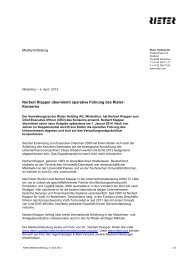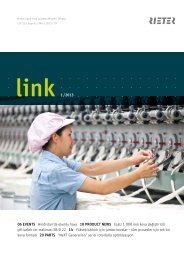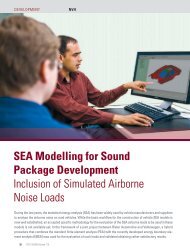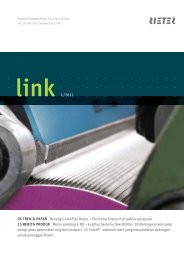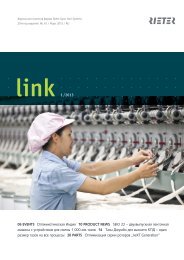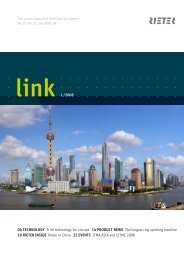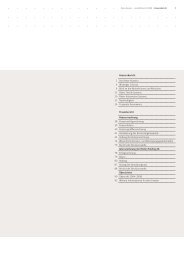Sound Quality Design - Rieter
Sound Quality Design - Rieter
Sound Quality Design - Rieter
You also want an ePaper? Increase the reach of your titles
YUMPU automatically turns print PDFs into web optimized ePapers that Google loves.
<strong>Sound</strong> <strong>Quality</strong> <strong>Design</strong><br />
Trends in Vehicle Acoustics<br />
he cars on European roads are 10<br />
T times quieter than they were 20<br />
years ago and standards have been set by<br />
the European Union requiring a further<br />
significant drop in traffic noise by 2010.<br />
From the consumer side, expectations of<br />
vehicle comfort are also increasing, which<br />
has compelled the highly competitive car<br />
industry to offer ever-quieter new models.<br />
In light of these strict regulations and market<br />
forces, the importance of acoustics or NVH<br />
(Noise Vibration Harshness) in the design of<br />
road vehicles immediately becomes clear –<br />
so much so that a great deal of the design of<br />
an acoustic package is done in the very early<br />
stages of this process, on virtual models.<br />
These models allow for simulation and<br />
measurement of the single components of a<br />
vehicle, including the acoustics. Performance<br />
can be predicted and refined well before the<br />
car, van, or truck takes to the road.<br />
The Power of Simulation<br />
Many challenges are on the table here - noise<br />
is present both inside and outside a vehicle.<br />
Exterior noise is typically the engine, the<br />
exhaust, and tyre noise on the road; this white<br />
sound combines to generate noise within the<br />
passenger compartment. Noise can be either<br />
airborne or structure borne and belongs to<br />
three frequency fields: low (equivalent to the<br />
sound of a powerful exhaust), mid (like the<br />
sound of a jet plane) and high (comparable<br />
to a whistling sound). Ways must be found<br />
to deal with these types of noise sources at<br />
any frequency – the mid and high frequencies<br />
particularly create the most difficulties.<br />
Complex software and computing power is<br />
needed so that the simulations and predictions<br />
can serve in the design of vehicles before<br />
the first run on the test track, when it is far<br />
too late to make modifications. Furthermore,<br />
prototypes are a costly item, so the more<br />
testing and validation that can be done well<br />
beforehand the better.<br />
NVH experts are continually developing and<br />
improving these sophisticated tools, which<br />
manage the full simulation chain - this starts<br />
BusinessForum China 1|07<br />
with an in-depth knowledge of acoustic<br />
materials behaviour, goes on through these<br />
materials being modeled into components, and<br />
culminates in the simulation of full vehicles.<br />
<strong>Sound</strong> Engineering<br />
So how do we deal with the noise once we<br />
have analysed, simulated, and measured<br />
it? By designing vehicles to reduce noise,<br />
vibration, and harshness and by equipping<br />
them with noise control components such<br />
as under engine shields, hoodliners, inner<br />
dashes, and carpet systems. Acoustic properties<br />
are engineered into these components and<br />
are tuned to reduce the noise from engines<br />
and tyres inside the vehicle via damping,<br />
insulation, and absorption. But at the same<br />
time cars have to be lighter, as this affects fuel<br />
consumption, their efficiency, and ultimately<br />
the environment. New technologies and hightech<br />
materials come into play when these<br />
components are designed and manufactured to<br />
be highly efficient and extremely lightweight.<br />
It is not simply a question of filling the<br />
car with absorption materials; the quality<br />
of sound and not just the quantity make a<br />
difference. The car should be well insulated<br />
but not all the sound should be absorbed, as<br />
each car typology and brand also has its own<br />
identifying sound – it is part of its appeal<br />
and must be carefully safeguarded. Here the<br />
current trend is all about subjective acoustics.<br />
Subjective Acoustics<br />
"How can I reduce the sound pressure level<br />
at the driver's ear by 3dB and at the same<br />
time decrease the overall weight of the<br />
acoustic package by 5 kg?" This question<br />
illustrates a typical concern of automotive<br />
engineers designing sound packages.<br />
But automotive acoustic designers have<br />
recently discovered that 'quieter' does not<br />
necessarily coincide with 'more pleasant';<br />
analysis of acoustic signals alone is not<br />
sufficient to identify the level of 'sound<br />
quality' inside a car. In addition to the quest<br />
for silence, weight, and cost reduction,<br />
the concept of 'sound quality design' has<br />
Main Topic | Automotive | Current Issues<br />
Jean-Charles Bonnet<br />
Head of Acoustics Laboratory<br />
<strong>Rieter</strong> Automotive China
Main Topic | Automotive | Current Issues<br />
The car should<br />
be well<br />
insulated but<br />
not all the<br />
sound should<br />
be absorbed,<br />
as each car<br />
typology and<br />
brand also<br />
has its own<br />
identifying<br />
sound.<br />
gained importance. Initially, sound quality<br />
design starts by identifying the attractive<br />
sound attributes from unpleasant ones.<br />
From this knowledge, the target sound is<br />
elaborated. Instead of classical acoustic tools<br />
and methodologies, the engineer relies on<br />
Psychoacoustics and Subjective Acoustics.<br />
Psychoacoustics<br />
Known as 'the science of the hearing<br />
system as a receiver of acoustical<br />
information', psychoacoustics uses various<br />
metrics to develop quantitative correlations<br />
between acoustical stimuli and the hearing<br />
sensation. Examples of these metrics are:<br />
Acoustics in China<br />
In the past, vehicle acoustics did not play as<br />
important a role in Chinese car production.<br />
There are a number of reasons for this:<br />


